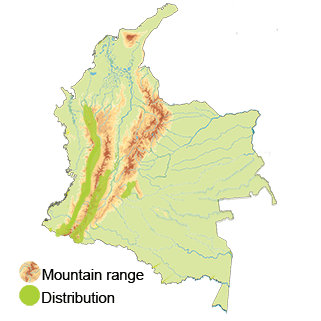White-throated Quail-dove
The White-throated Quail-Dove (Zentrygon frenata). Read in Spanish
Appearance: The White-throated Quail-Dove is a medium-sized dove known for its striking appearance. It has a distinctive white patch on its throat, contrasting with its dark plumage. The bird's upperparts are typically dark brown or grayish-brown, while the underparts are a lighter shade. It has a red eye ring and a prominent red bill.
Habitat: These doves are typically found in humid montane forests and cloud forests in the Andes of Colombia, especially at elevations above 1,000 meters. They are known to inhabit dense vegetation, often near streams or ravines, where they can forage for fruits, seeds, and small invertebrates.
Behavior: White-throated Quail-Doves are generally shy and secretive birds that prefer to remain hidden in the understory of the forest. They are mainly ground-dwelling birds, foraging for food on the forest floor. They are known for their low cooing calls that echo through the forest.
Breeding: These doves typically build flimsy nests in trees or shrubs, where the female lays one or two eggs. Both parents take turns incubating the eggs and caring for the young chicks. Breeding may coincide with the rainy season, providing abundant food resources for the growing family.
Conservation Status: The White-throated Quail-Dove in Colombia is considered vulnerable due to habitat loss and fragmentation caused by deforestation, agriculture, and human activities.
Distribution
The White-throated Quail-dove (Zentrygon frenata)
These birds are generally found in humid forests, including cloud forests and tropical lowland forests. Within Colombia, they may be distributed in areas such as the Andean regions, the Chocó biogeographic region, the Amazon rainforest, and other suitable habitats across the country.
The distribution of the white-throated quail dove in Colombia may vary based on factors such as elevation, climate, vegetation types, and availability of food resources. Protected areas, national parks, and reserves in Colombia may also serve as important habitats for the conservation of this species.
Taxonomy
The White-throated Quail-dove (Zentrygon frenata)
- Kingdom: Animalia
- Phylum: Chordata
- Class: Aves (Birds)
- Order: Columbiformes
- Family: Columbidae
- Genus: Zentrygon
- Species: Zentrygon frenata
Vocalization
The White-throated Quail-Dove (Zentrygon frenata).
- Call: The vocalization of the White-throated Quail-Dove is a series of soft, low-pitched, mournful cooing sounds. The call is often described as a rhythmic "coo-COO-co-coo" or "coo-coo-COO-coo," with each note followed by a pause. This gentle and melodious sound is commonly heard in the early morning and evening hours, echoing through the dense forests where these doves reside.
- Territorial Calls: White-throated Quail-Doves use their vocalizations to establish and defend territories within their habitat. Males may intensify their calls during the breeding season to attract mates and deter rival males. These territorial calls serve as a means of communication to other doves in the area and help maintain boundaries.
- Courtship Displays: During courtship and bonding rituals, White-throated Quail-Doves may engage in coordinated vocalizations with their potential mates. These vocal displays can include soft hoots, purring sounds, and soft whistles, all of which help strengthen pair bonds and signal readiness for mating.
- Contact Calls: In addition to territorial and courtship vocalizations, White-throated Quail-Doves use contact calls to stay in touch with their family members and flock mates. These calls can vary in tone and intensity, allowing individuals to locate each other in the dense vegetation of their forest habitat.
- Parental Communication: White-throated Quail-Doves also use specific vocalizations to communicate with their offspring, signaling danger, food availability, or other important information.




